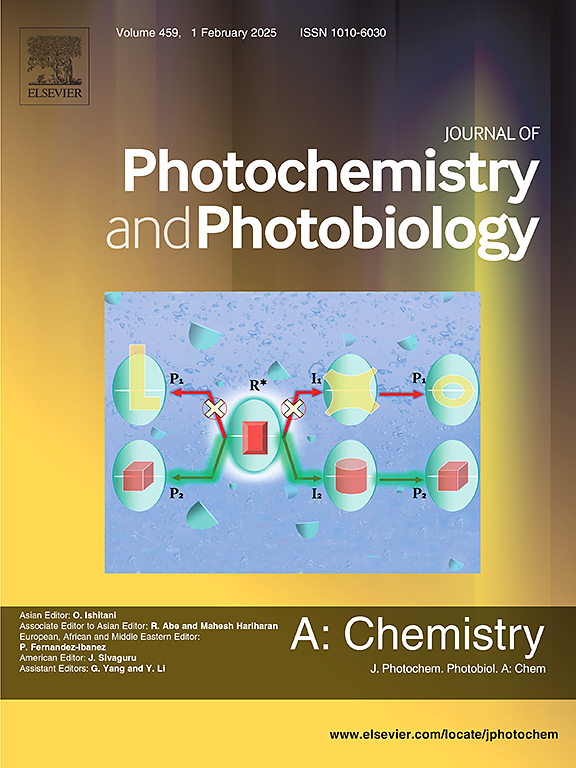Baicalein-conjugated carbon dots as photoluminescent nanoprobes for enhanced antioxidant activity, bioimaging, and selective Fe3+ sensing
IF 4.7
3区 化学
Q2 CHEMISTRY, PHYSICAL
Journal of Photochemistry and Photobiology A-chemistry
Pub Date : 2025-07-25
DOI:10.1016/j.jphotochem.2025.116654
引用次数: 0
Abstract
Modulating iron levels and reactive oxygen species (ROS) in cancer cells and the tumor microenvironment has emerged as a promising strategy for cancer therapy. Carbon dots (CDs) functionalized with antioxidant properties hold significant potential for addressing oxidative stress-related pathologies and enabling multifunctional bioimaging. Herein, we report the development of baicalein-conjugated carbon dots (Ba/CDs), a novel photoluminescent nanomaterial designed to enhance antioxidant capacity. Characterized by Transmission Electron Microscopy (TEM), X-Ray Diffraction (XRD), Fourier Transform Infrared Spectroscopy (FT-IR), and X-ray Photoelectron Spectroscopy (XPS), Ba/CDs exhibited threefold higher antioxidant efficiency than free baicalein, validated by Ultraviolet-Visible (UV–Vis) spectroscopy, fluorescence spectroscopy, DPPH radical scavenging assays, and H2O2 removal experiments. The nanohybrids demonstrated excellent biocompatibility, efficient cellular uptake, and utility for bioimaging applications. As a fluorescent probe, Ba/CDs enabled selective detection of Fe3+ with a linear response range of 0.1–60 μM and a low detection limit of 84.3 nM. This multifunctional nanoprobe integrates antioxidant activity, bioimaging, and metal ion sensing, offering transformative potential for addressing redox imbalance-related diseases (e.g., cancer) and advancing carbon-based nanomedicine in photochemical and photobiological contexts.

黄芩素共轭碳点作为光致发光纳米探针用于增强抗氧化活性,生物成像和选择性Fe3+传感
调节癌细胞和肿瘤微环境中的铁水平和活性氧(ROS)已成为一种有前途的癌症治疗策略。具有抗氧化特性的功能化碳点(CDs)在解决氧化应激相关病理和实现多功能生物成像方面具有重要潜力。在此,我们报道了黄芩素共轭碳点(Ba/CDs)的发展,这是一种新型的光致发光纳米材料,旨在提高抗氧化能力。通过透射电子显微镜(TEM)、x射线衍射(XRD)、傅里叶变换红外光谱(FT-IR)和x射线光电子能谱(XPS)对Ba/CDs的抗氧化效率进行了表征,并通过紫外可见光谱(UV-Vis)、荧光光谱、DPPH自由基清除实验和H2O2去除实验验证了Ba/CDs的抗氧化效率是游离黄芩苷的三倍。纳米杂交体表现出优异的生物相容性,高效的细胞摄取和生物成像应用的实用性。作为荧光探针,Ba/CDs对Fe3+具有选择性检测,线性响应范围为0.1 ~ 60 μM,检出限低至84.3 nM。这种多功能纳米探针集成了抗氧化活性、生物成像和金属离子传感,为解决氧化还原失衡相关疾病(如癌症)和推进光化学和光生物学背景下的碳基纳米医学提供了变革潜力。
本文章由计算机程序翻译,如有差异,请以英文原文为准。
求助全文
约1分钟内获得全文
求助全文
来源期刊
CiteScore
7.90
自引率
7.00%
发文量
580
审稿时长
48 days
期刊介绍:
JPPA publishes the results of fundamental studies on all aspects of chemical phenomena induced by interactions between light and molecules/matter of all kinds.
All systems capable of being described at the molecular or integrated multimolecular level are appropriate for the journal. This includes all molecular chemical species as well as biomolecular, supramolecular, polymer and other macromolecular systems, as well as solid state photochemistry. In addition, the journal publishes studies of semiconductor and other photoactive organic and inorganic materials, photocatalysis (organic, inorganic, supramolecular and superconductor).
The scope includes condensed and gas phase photochemistry, as well as synchrotron radiation chemistry. A broad range of processes and techniques in photochemistry are covered such as light induced energy, electron and proton transfer; nonlinear photochemical behavior; mechanistic investigation of photochemical reactions and identification of the products of photochemical reactions; quantum yield determinations and measurements of rate constants for primary and secondary photochemical processes; steady-state and time-resolved emission, ultrafast spectroscopic methods, single molecule spectroscopy, time resolved X-ray diffraction, luminescence microscopy, and scattering spectroscopy applied to photochemistry. Papers in emerging and applied areas such as luminescent sensors, electroluminescence, solar energy conversion, atmospheric photochemistry, environmental remediation, and related photocatalytic chemistry are also welcome.

 求助内容:
求助内容: 应助结果提醒方式:
应助结果提醒方式:


